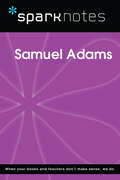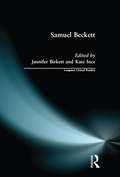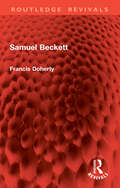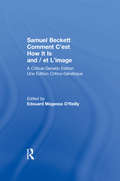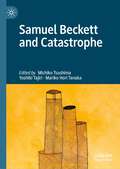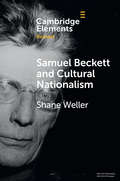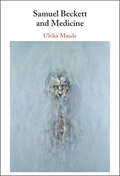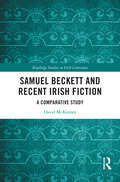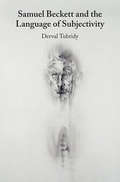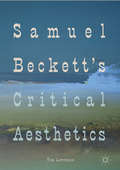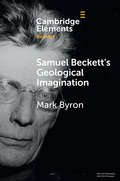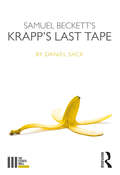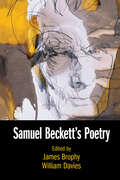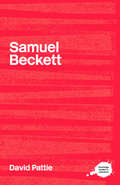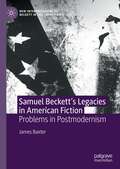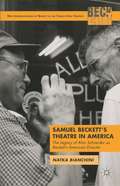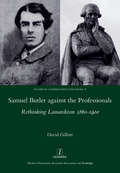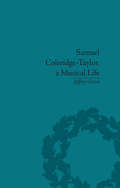- Table View
- List View
Samuel Adams (SparkNotes Biography Guide)
by SparkNotesSamuel Adams (SparkNotes Biography Guide) Making the reading experience fun! SparkNotes Biography Guides examine the lives of historical luminaries, from Alexander the Great to Virginia Woolf. Each biography guide includes:An examination of the historical context in which the person lived A summary of the person&’s life and achievements A glossary of important terms, people, and events An in-depth look at the key epochs in the person&’s career Study questions and essay topics A review test Suggestions for further reading Whether you&’re a student of history or just a student cramming for a history exam, SparkNotes Biography guides are a reliable, thorough, and readable resource.
Samuel Beckett
by L. Graver R. FedermanThis set comprises 40 volumes covering 19th and 20th century European and American authors. These volumes will be available as a complete set, mini boxed sets (by theme) or as individual volumes. This second set compliments the first 68 volume set of Critical Heritage published by Routledge in October 1995.
Samuel Beckett (Longman Critical Readers)
by Jennifer Birkett Kate InceBringing together seminal writings on Beckett from the 1950s and 1960s with critical readings from the 1980s and 1990s, this collection is inspired by a wide variety of literary-theoretical approaches and covers the whole range of Beckett's creative work. Following an up-to-date review and analysis of Beckett criticism, fifteen extracts of Beckett criticism are introduced and set in context by editors' headnotes. The book aims to make easily accessible to students and scholars stimulating and innovative writing on the work of Samuel Beckett, representing the wide range of new perspectives opened up by contemporary critical theory: philosophical, political and psychoanalytic criticism, feminist and gender studies, semiotics, and reception theory.
Samuel Beckett (Routledge Revivals)
by Francis DohertyOriginally published in 1971, this book elucidates Beckett’s work in the light of his concern with literary form. This is seen as an increasingly compressed and dense medium for the purer and purer statement of his view of man’s existence, and Beckett’s Man is seen as the medium for the articulation of a view of the world which is both comically cruel and anti-theological, but not atheist. The book discusses his work as a novelist and playwright – his best-known play, Waiting for Godot, being seen in the context of his many other important plays, and more than twenty years of previous writing.
Samuel Beckett Comment C'est How It Is And / et L'image: A Critical-Genetic Edition Une Edition Critic-Genetique
by Samuel BeckettThis book contains the English and French texts and a complete record of the genesis of each. Besides Comment C'est How It Is, O'Reilly has included L'Image and an excerpt from Comment C'est that was published later in another volume.
Samuel Beckett and Catastrophe
by Mariko Hori Tanaka Yoshiki Tajiri Michiko TsushimaSamuel Beckett and Catastrophe is a groundbreaking collection of original essays that explore the relation between Samuel Beckett and catastrophe in terms of war, the Holocaust, nuclear disasters and ecological crisis. Responding to the post-catastrophic situations in the twentieth century, Beckett created characters who often seem to have been through an unknown catastrophe. Although the importance of catastrophe in Beckett has been noted sporadically, there has been no substantial attempt to discuss his aesthetics and work in relation to it. This collection will therefore serve as the first sustained study to explore the theme of catastrophe in Beckett and will be a highly significant contribution to Beckett studies.
Samuel Beckett and Cultural Nationalism (Elements in Beckett Studies)
by Shane WellerDrawing on evidence from his published works, manuscripts, and correspondence, Samuel Beckett and Cultural Nationalism explores Beckett's engagement with the theme of cultural nationalism throughout his writing life, revealing the various ways in which he sought to challenge culturally nationalist conceptions of art and literature, while never embracing a cosmopolitan approach. The Element shows how, in his pre-Second World War writings, Beckett sought openly to mock Irish nationalist ideas of culture and language, but that, in so doing, he failed to avoid what he himself described as a 'clot of prejudices'. In his post-war works in French and English, however, following time spent in Nazi Germany in 1936-7 as well as in the French Resistance during the Second World War, Beckett began to take a new approach to ideas of national-cultural affiliation, at the heart of which was a conception of the human as a citizen of nowhere.
Samuel Beckett and Medicine
by Ulrika MaudeSamuel Beckett and Medicine offers the first sustained analysis of the author's abiding interest in medicine and medical discourses, advancing insights into the representation of illness, neurodiversity, disability, ageing, and dying in his work. It analyses Beckett's representation of the production of language, offering new ways of understanding the often perplexing formal and stylistic experimentation of his work. The book addresses the many automatic and habitual functions staged in his writing and considers the impact of nerve theory, reflexes, affect, and the viscera on his work. It advances new readings of Beckett's poetry, prose, and television and stage plays, drawing on his reading notes on medicine and psychology, and on his correspondence and critical writings. Through its refusal to aestheticize embodied experience or to yield to the metaphysical consolations of literature, Beckett's work challenges us to confront the intricacies of embodied being and to encounter the question of finitude.
Samuel Beckett and Recent Irish Fiction: A Comparative Study (Routledge Studies in Irish Literature)
by David McKinneyThis volume considers Samuel Beckett’s fiction and drama as major aesthetic and thematic influences on the work of Irish authors Eimear McBride, Keith Ridgway, Emma Donoghue, and Kevin Barry in the post-crash period of 2009–2015. Through cross-comparisons between the aesthetics and form of Beckett’s Trilogy, Mercier and Camier, Footfalls and Not I, and those of a range of post-crash Irish novels including Beatlebone, Hawthorn and Child, Room, and A Girl Is A Half-Formed Thing, this book establishes Beckett’s continuing influence on Irish fiction. With particular reference to these newer authors’ treatment of scarcity, trauma, indeterminism, gender and sexuality, and confinement in the context of major societal changes and traumas in Irish society since 2009, topics include the imposition of austerity, collapse of faith in institutions, and the increasing recognition of LGBTQIA+ and reproductive rights.
Samuel Beckett and the Arts: Music, Visual Arts and Non-Print Media (Routledge Library Editions: Beckett #4)
by Lois OppenheimThis book, first published in 1999, addresses Beckett’s visual and musical sensibilities, and examines his visionary use of such diverse modes of creative expression as stage, radio, television and film, when his medium was the written word. The first section of the book focuses on music; the second part analyses the visual arts; and the third part examines film, radio and television. This book uncovers aspects of his thinking on, and use of the arts that have been little studied, including the nonfigurative function of music and art in Beckett’s work; the ‘collaborations’ undertaken by composers, painters and choreographers with his texts; the relation of his literary to his visual and musical artistry; and his use of film, radio and television as innovative means and celebration of artistic process.
Samuel Beckett and the Language of Subjectivity
by Derval TubridySamuel Beckett and the Language of Subjectivity is the first sustained exploration of aporia as a vital, subversive, and productive figure within Beckett's writing as it moves between prose and theatre. Informed by key developments in analytic and continental philosophies of language, Tubridy's fluent analysis demonstrates how Beckett's translations - between languages, genres, bodies, and genders - offer a way out of the impasse outlined in his early aesthetics. The primary modes of the self's extension into the world are linguistic (speaking, listening) and material (engaging with bodies, spaces and objects). Yet what we mean by language has changed in the twenty-first century. Beckett's concern with words must be read through the information economy in which contemporary identities are forged. Derval Tubridy provides the groundwork for new insights on Beckett in terms of the posthuman: the materialist, vitalist and relational subject cathected within differential mechanisms of power.
Samuel Beckett's Critical Aesthetics
by Tim LawrenceThis book considers how Samuel Beckett’s critical essays, dialogues and reflections drew together longstanding philosophical discourses about the nature of representation, and fostered crucial, yet overlooked, connections between these discourses and his fiction and poetry. It also pays attention to Beckett’s writing for little-magazines in France from the 1930s to the 1950s, before going on to consider how the style of Beckett’s late prose recalls and develops figures and themes in his critical writing. By providing a long-overdue assessment of Beckett’s work as a critic, this study shows how Beckett developed a new aesthetic in knowing dialogue with ideas including phenomenology, Kandinsky’s theories of abstraction, and avant-garde movements such as Surrealism. This book will be illuminating for students and researchers interested not just in Beckett, but in literary modernism, the avant-garde, European visual culture and philosophy.
Samuel Beckett's Geological Imagination (Elements in Beckett Studies)
by Mark ByronSamuel Beckett's Geological Imagination addresses the ubiquity of earthy objects in Beckett's prose, drama and poetry, exploring how mineral and archaeological objects bear upon the themes, narrative locus, and sensibilities of Beckett's texts in surprisingly varied ways. By deploying figures of ruination and excavation with etymological self-awareness, Beckett's late prose narratives – Company, Ill Seen Ill Said, and Worstward Ho – comprise a late-career meditation on the stratigraphic layerings of language and memory over an extended writing career. These layers comprise an embodied record of writing in their allusions to literary history and to Beckett's own oeuvre.
Samuel Beckett's Krapp's Last Tape (The Fourth Wall)
by Daniel Sack"We lay there without moving. But under us all moved, and moved us." - Krapp Samuel Beckett’s most accessible play is also one of the twentieth century’s most moving dramas about aging, memory, and disappointment. Daniel Sack offers the first comprehensive survey of Krapp’s Last Tape (1958) with a general reader in mind. Structured around a series of questions, five approachable sections contextualize the play in the larger career of its Nobel-Prize-winning writer, explore its major thematic concerns, and offer comparative analyses with Beckett’s other signal works. Sack also uses discussions of significant productions, including those directed by the playwright himself, to ground interpretation of the play in terms of its performance and provide a useful resource to directors and actors. Both a critical and personal exploration of this haunting play, this volume is a must-read for anyone with an interest in Beckett’s work.
Samuel Beckett's Poetry
by William Davies James BrophySamuel Beckett's Poetry is the first book-length study of Beckett's complete poetry, designed for students and scholars of twentieth century poetry and literature, as well as for specialists of Beckett's work. This volume explores how poetry provided Beckett a medium of expression during key moments in his life, from his earliest attempts at securing a reputation as a published writer, to the work of restoring his own speech while suffering aphasia shortly before his death. Often these were moments of desperation and discouragement, when more substantial works were not possible: moments of illness, of personal loss or of public disaster. This volume includes an introduction that contextualizes Beckett as a poet and a chronology of the composition and publication of all his known poems. Essays offer a range of critical perspectives, from translation theory, war poetics and Irish Studies to Beckett's debts to Modernism, Romanticism and the Jazz Age.
Samuel Beckett: Anatomy of a Literary Revolution
by Pascale CasanovaIn this fascinating new exploration of Samuel Beckett&’s work, Pascale Casanova argues that Beckett&’s reputation rests on a pervasive misreading of his oeuvre, which neglects entirely the literary revolution he instigated. Reintroducing the historical into the heart of this body of work, Casanova provides an arresting portrait of Beckett as radically subversive—doing for writing what Kandinsky did for art—and in the process presents the key to some of the most profound enigmas of Beckett&’s writing.
Samuel Beckett: Intersections With Popular Culture (Routledge Guides to Literature #6)
by David PattieSamuel Beckett's work forever changed the concepts of literature and theatre. His work remains a core part of introductory courses on literary history, drama, theatre or performance and also features in more specialist modules such as Modernism or The Absurd. Samuel Beckett is a comprehensive introduction to his life and work as well as an outline of the critical issues surrounding his work. This guidebook leaves judgements up to the student by explaining the full range of often very different critical views and interpretations and offers guides to further reading in each area discussed.
Samuel Beckett’s Italian Modernisms: Tradition, Texts, Performance (Routledge Advances in Theatre & Performance Studies)
by Michela Bariselli Davide Crosara Antonio Gambacorta Mario MartinoIn the wake of both Joycean and Dantean celebrations, this volume aims to investigate the fecund influence of Italian culture on Samuel Beckett’s work, with a specific focus on the twentieth century.Located at the intersection of historical avant-garde movements and a renewed interest in tradition, Italian modernism reimagined Italy and its culture, projecting it beyond the shadow of fascism. Following in Joyce’s footsteps, Samuel Beckett soon became an attentive reader of Italian modernist authors. These had a profound effect on his early work, shaping his artistic identity. The influence of his early readings found its way also into Beckett’s postwar writing and, most poignantly, in his theatre. The contributions in this collection rekindle the debate around Beckett as modernist author through the lenses of Italian culture.This study will be of particular interest to students and scholars in theatre and performance studies, Italian studies, English studies, and comparative literature.
Samuel Beckett’s Legacies in American Fiction: Problems in Postmodernism (New Interpretations of Beckett in the Twenty-First Century)
by James BaxterSamuel Beckett’s Legacies in American Fiction provides an overdue investigation into Beckett’s rich influences over American writing. Through in-depth readings of postmodern authors such as Robert Coover, Donald Barthelme, Thomas Pynchon, Don DeLillo, Paul Auster and Lydia Davis, this book situates Beckett’s post-war writing of exhaustion and generation in relation to the emergence of an explosive American avant-garde. In turn, this study provides a valuable insight into the practical realities of Beckett’s dissemination in America, following the author’s long-standing relationship with the countercultural magazine Evergreen Review and its dramatic role in redrawing the possibilities of American culture in the 1960s. While Beckett would be largely removed from his American context, this book follows his vigorous, albeit sometimes awkward, reception alongside the authors and institutions central to shaping his legacies in 20th and 21st century America.
Samuel Beckett’s Theatre in America
by Natka BianchiniA study of the 30-year collaboration between playwright Samuel Beckett and director Alan Schneider, Bianchini reconstructs their shared American productions between 1956 and 1984. By examining how Beckett was introduced to American audiences, this book leads into a wider historical discussion of American theatre in the mid-to-late 20th century.
Samuel Butler against the Professionals: Rethinking Lamarckism 1860-1900
by David GillottIn the wake of the 2009 Darwin bicentenary, Samuel Butler (1835-1902) is becoming as well known for his public attack on Darwin's character and the basis of his scientific authority as for his novels Erewhon and The Way of All Flesh. In the first monograph devoted to Butler's ideas for over twenty years, David Gillott offers a much-needed reappraisal of Butler's work and shows how Lamarckian ideas pervaded the whole of Butler's wide-ranging ouevre, and not merely his evolutionary theory. In particular, he argues that Lamarckism was the foundation on which Butler's attempt to undermine professional authority in a variety of disciplines was based. Samuel Butler against the Professionals provides new insight into a fascinating but often misunderstood writer, and on the surprisingly broad application of Lamarckian ideas in the decades following publication of the Origin of Species.
Samuel Butler, Victorian Against the Grain
by James G. ParadisSamuel Butler (1835-1902), Victorian satirist, critic, and visual artist, possessed one of the most original and inquiring imaginations of his age. The author of two satires, Erewhon (1872) and The Way of All Flesh (1903), Butler's intellectually adventurous explorations along the cultural frontiers of his time appeared in volume after eccentric volume. Author of four works on evolution, he was one of the most prolific evolutionary speculators of his time. He was an innovative travel writer and art historian who used the creative insights of his own painting, photography, and local knowledge to invent, in works like Alps and Sanctuaries (1881), a vibrant Italian culture that contrasted with the spiritually frigid experience of his High Church upbringing.Despite his range and achievement, there remains surprisingly little contemporary analytical commentary on Butler's work. Samuel Butler, Victorian against the Grain is an interdisciplinary collection of essays that provides a critical overview of Butler's career, one which places his multifaceted body of work within the cultural framework of the Victorian age. The essays, taken together, discuss the formation of Victorian England's ultimate polymath, an artistic and intellectual ventriloquist who assumed an extraordinary range of roles - as satirist, novelist, evolutionist, natural theologian, travel writer, art historian, biographer, classicist, painter, and photographer.
Samuel Coleridge-Taylor, a Musical Life
by Jeffrey GreenGreen’s study is more than a biography of an Anglo-African composer.The first comprehensive study of Coleridge-Taylor’s life for almost a century, it reveals how class-ridden Britain could embrace even the most unlikely of cultural icons.
Samuel Johnson
by MeyersFord Madox Ford declared Samuel Johnson "the most tragic of all our major literary figures. ” Blessed with a formidable intellect and a burning passion for ideas, Johnson also struggled throughout his life with mental instability and numerous physical defects. One of the most illustrious figures of the English literary tradition, Johnson made his fame as poet, essayist, critic, dictionary-maker, conversationalist, and all-around larger-than-life personality. His success was all the greater for the adversity he had to overcome in achieving it. Drawing on a lifetime of study of Johnson and his era, as well as a wide array of new archival materials, noted biographer Jeffrey Meyers tells the extraordinary story of one of the great geniuses of English letters. Johnson emerges in his portrait as a mass of contradictions: lazy and energetic, aggressive and tender, melancholy and witty, comforted yet tormented by religion. He was physically repulsive and slovenly in dress and habits, but his social ideas were progressive and humane--he strongly opposed slavery and the imperial exploitation of indigenous peoples. He gave generously to the poor and homeless, rescued prostitutes, and defended criminals who’d been condemned to hang. But these charitable acts could not dispel the darkness that clouded his world: overwhelming guilt and fear of eternal damnation. A masterful portrait of a brilliant and tormented figure, this book reintroduces a new generation of readers to the heroic Dr. Johnson.
